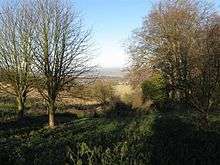Smithcombe, Sharpenhoe and Sundon Hills
| Site of Special Scientific Interest | |
 View of Sharpenhoe | |
| Area of Search | Bedfordshire |
|---|---|
| Grid reference | TL063298 |
| Interest | Biological |
| Area | 86.1 hectares |
| Notification | 1985 |
| Location map | Magic Map |
Smithcombe, Sharpenhoe and Sundon Hills is an 86.1 hectare Site of Special Scientific Interest in Sharpenhoe in Bedfordshire. Most of it is a National Trust property comprising Sundon Hills, Moleskin and Markham Hills, Sharpenhoe Clappers and Smithcombe Hills. It is part of the Chilterns Area of Outstanding Natural Beauty, and Sharpenhoe Clappers is a Scheduled Ancient Monument.[1][2][3]
Much of the site is unimproved chalk grassland with many plants which are now rare, and Festuca ovina is dominant over large areas. Orchids include Herminium monorchis and Aceras anthropophorum. An uncommon rose, Rosa stylosa, is found in scrub areas. There is also beech forest with a ground layer including primroses.[1]
Clappers are rabbit warrens, and meat, fur and leather from rabbits used to be an important part of the local economy.[4] Sharpenhoe Clappers is an Iron Age hill fort, together with medieval rabbit warrens and associated agricultural earthworks.[5]
There is access to the National Trust property from Sharpenhoe Road.[3]
| Wikimedia Commons has media related to Smithcombe, Sharpenhoe and Sundon Hills. |
References
- 1 2 "Smithcombe, Sharpenhoe and Sundon Hills citation" (PDF). Sites of Special Scientific Interest. Natural England. Retrieved 31 August 2015.
- ↑ "Map of Smithcombe, Sharpenhoe and Sundon Hills". Sites of Special Scientific Interest. Natural England. Retrieved 31 August 2015.
- 1 2 "Sharpenhoe". National Trust. Retrieved 31 August 2015.
- ↑ "Sharpenhoe Clappers". Chilterns Conservation Board. Retrieved 31 August 2015.
- ↑ "Sharpenhoe Clappers". Historic England. Retrieved 31 August 2015.
Coordinates: 51°57′28″N 0°26′42″W / 51.95776°N 0.444983°W